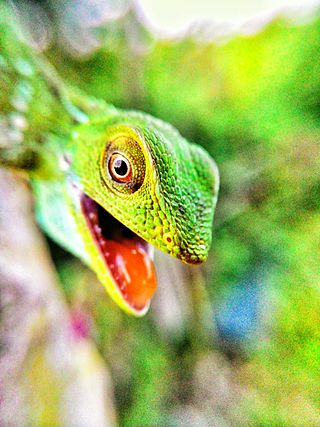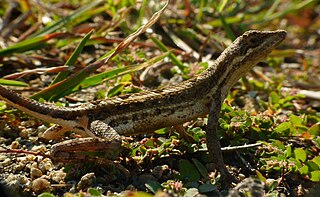
Ceratophora is a genus of agamid lizards found in Sri Lanka. The male has a horn on its snout.

Pseudocalotes is a genus of lizards in the family Agamidae. The genus is endemic to Southeast Asia.

Bronchocela jubata, commonly known as the maned forest lizard, is a species of agamid lizard found mainly in Indonesia on the islands of Singkep, Java, Bali, Sulawesi, Karakelang, Salibabu; Nias Island, Singkap Island, Borneo (Kalimantan) also in Thailand, Cambodia and Philippines. Although in the past it was thought the species may be found in India, either on the mainland or in the Nicobars, this is not the case according to herpetologist Das. It is also known by the common name of "bloodsucker", although this is a misnomer.

Monilesaurus ellioti, also known commonly as Elliot's forest lizard, is a species of arboreal, diurnal, lizard in the family Agamidae. The species is endemic to the Western Ghats, India.

Calotes emma, commonly known as the forest garden lizard or Emma Gray's forest lizard, is a species of lizard in the family Agamidae. The species is native to China, South Asia, and Southeast Asia. There are two recognized subspecies.

Calotes mystaceus, the Indo-Chinese forest lizard or blue crested lizard, is an agamid lizard found in China, South Asia and Southeast Asia.

Draco blanfordii, commonly known as Blanford's flying dragon, Blanford’s flying lizard, or Blanford's gliding lizard, is a species of "flying" lizard in the family Agamidae. The species is endemic to Asia, and is capable of gliding from tree to tree.

Agasthyagama beddomii, commonly known as the Indian kangaroo lizard, is a diurnal, terrestrial, insectivorous agamid lizard, endemic to the Western Ghats of South India.

Blanford's rock agama is species of lizard in the family Agamidae. The species is endemic to Peninsular India. One of two species in the genus, P. blanfordanus is found mainly to the east of the distribution of P. dorsalis. Unlike the other species, the male P. blanfordanus in breeding season has the red body color restricted to the head and lacks the broad dorsal stripe.

Salea horsfieldii, commonly known as Horsfield's spiny lizard or the Nilgiri salea, is a species of lizard in the family Agamidae. The species is endemic to the Nilgiri Hills of India. It is found mainly in the high altitude grassy hills. A related species, Salea anamallayana, is found in the grassy hills of the Anaimalai Hills.

The Pondichéry fan-throated lizard is a species of agamid lizard found in eastern peninsular India. It was earlier thought to be widespread but studies in 2016 resulted in the splitting of the group into several species placed in two genera. The genus Sitana has an enlarged projecting scale on the posterior side of the hind thigh which is absent in the sister genus Sarada.

Dopasia gracilis, known commonly as the Asian glass lizard, the Burmese glass lizard, or the Indian glass snake, is a species of legless lizard in the family Anguidae. The species is endemic to Asia.
Jerdon's day gecko is a species of gecko, a lizard in the family Gekkonidae. The species is endemic to India and Sri Lanka.

The Malayan forest gecko or banded bent-toed gecko is a species of gecko found in Southeast Asia.
Hemidactylus karenorum, commonly known as the Burmese leaf gecko, the Burmese leaf-toed gecko, or the Burmese spotted gecko, is a species of gecko, a lizard in the family Gekkonidae. The species is endemic to Southeast Asia.

The Indian fringe-fingered lizard, also known commonly as the Indian fringe-toed lizard, is a species of lizard in the family Lacertidae. The species is endemic to Asia.

Ophisops jerdonii, commonly known as Jerdon's cabrita, Jerdon's snake-eye, or Punjab snake-eyed lacerta, is a species of lacertid lizard, which is distributed in east Afghanistan, Pakistan, and India.

Ophisops leschenaultii, commonly called Leschenault's snake-eye, Leschenault’s lacerta, or Leschenault's cabrita, is a species of lacertid lizard endemic to India and eastern Sri Lanka. In Sri Lanka, this lizard is called Pandura katussa in Sinhala. In some parts of the country, it is also called Heeraluwa or sikanala, which is more common name for all skink-like reptiles.
Eutropis beddomei, commonly known as Beddome's mabuya or Beddome's skink, is a species of lizard in the family Scincidae. The species is native to India and Sri Lanka.

Pseudocalotes floweri, also commonly known as Flower's forest agamid, Flower's long-headed lizard, and the Thai false bloodsucker, is a species of lizard in the family Agamidae. The species is native to Southeast Asia.


















